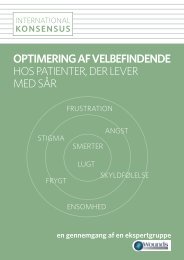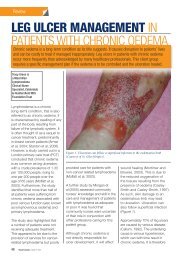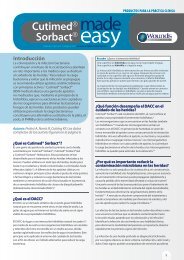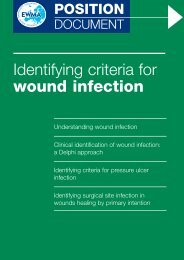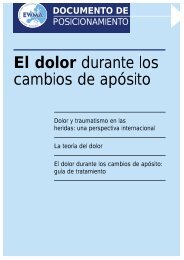Dressings can prevent pressure ulcers: fact or fallacy? - Wounds ...
Dressings can prevent pressure ulcers: fact or fallacy? - Wounds ...
Dressings can prevent pressure ulcers: fact or fallacy? - Wounds ...
- No tags were found...
Create successful ePaper yourself
Turn your PDF publications into a flip-book with our unique Google optimized e-Paper software.
Clinical REVIEW8 Pressure duration over the <strong>pressure</strong>points which <strong>can</strong> result in damagefrom high <strong>pressure</strong> f<strong>or</strong> sh<strong>or</strong>t intenseperiods, which <strong>can</strong> be as damaging aslow <strong>pressure</strong> f<strong>or</strong> prolonged periods(Bell, 2005)8 Collagen function protecting themicrocirculation helps to maintainthe <strong>pressure</strong>s inside and outsidethe cells <strong>prevent</strong>ing cell bursting.Collagen levels vary from personto person with lessening protectivequalities with aging (Russell, 1998)8 Aut<strong>or</strong>egulat<strong>or</strong>y processes initiatedwhen external <strong>pressure</strong> is sensed,leading to increased internal capillary<strong>pressure</strong>, reduced blood flow andreactive hyperaemia to counteractthe <strong>pressure</strong> loading.These mechanisms <strong>can</strong> fail when theexternal <strong>pressure</strong> exceeds the person’sdiastolic <strong>pressure</strong> rather than the32mmHg often quoted (Nixon, 2001).The response of tissue to externalf<strong>or</strong>ces varies greatly, being dependenton a large number of <strong>fact</strong><strong>or</strong>s. It istheref<strong>or</strong>e not possible to establish a‘safe level of <strong>pressure</strong>’. In addition,tolerance to <strong>pressure</strong> <strong>can</strong> vary greatlyfrom individual to individual due tothe interplay of external <strong>fact</strong><strong>or</strong>s listedin Table 1. Given the highly variablenature of <strong>pressure</strong> transmission, capillaryclosure and the individual’s n<strong>or</strong>mal andadaptive responses to <strong>pressure</strong> stress,the production of time/<strong>pressure</strong> curves(mathematical models f<strong>or</strong> predicting thetime likely to cause tissue damage whentissue is exposed to specific levels of<strong>pressure</strong> [Reswick and Rogers, 1976])may be of little practical benefit to theclinician in everyday practice (Sharp andMcLaws, 2005; Grefen, 2009).Shear is a mechanical stress appliedparallel to the skin. The SFI describes itas: ‘An action <strong>or</strong> stress resulting fromapplied f<strong>or</strong>ces which causes <strong>or</strong> tends tocause two contiguous internal parts ofthe body to def<strong>or</strong>m in the transverseplane (i.e. “shear strain”)’ (SFI, 2006).This sliding <strong>or</strong> twisting f<strong>or</strong>ce occurscontinuously within soft tissues evenwhen perpendicular <strong>pressure</strong> is applied,but increases greatly when combinedwith lateral movement, as seen when84 <strong>Wounds</strong> uk, 2009, Vol 5, No 4the body is adapting to the inclinationof the bed <strong>or</strong> when sitting in a chair. Ifthe skin adheres to the surface supp<strong>or</strong>t(which is m<strong>or</strong>e likely if the skin is moist<strong>or</strong> wet from environmental <strong>fact</strong><strong>or</strong>s<strong>or</strong> intrinsically from incontinence <strong>or</strong>sweating) (Weir, 2007; Beldon, 2008), thetissues attached to the gradually movingskeletal frame become dist<strong>or</strong>ted which,in turn, dist<strong>or</strong>t the blood vessels leadingto their collapse <strong>or</strong> rupture.Shear f<strong>or</strong>ces are generated as aresult of the interplay of friction and<strong>pressure</strong> (Collier and Mo<strong>or</strong>e, 2006).When applied, shear increases theeffects of <strong>pressure</strong> resulting in vascularocclusion at only half the <strong>pressure</strong> ofnon-stressed tissues (Bennett and Lee,1986). Shear f<strong>or</strong>ces may also have asignifi<strong>can</strong>t role in the development ofdeep tissue damage, although this isdifficult to measure in the clinical setting(Russell, 1998). Potentially, shearing isthe most serious extrinsic risk <strong>fact</strong><strong>or</strong>due to the rapidity with which it <strong>can</strong>result in tissue damage (Sharp andMcLaws, 2005). This is m<strong>or</strong>e likely tooccur in the elderly as a result of loose,fragile skin and the ease with which thedifferent tissue types <strong>can</strong> be sheared offtheir respective attachments (Allman etal, 1995).The edges of <strong>ulcers</strong> caused by shearf<strong>or</strong>ces appear to be ragged with m<strong>or</strong>euneven wound margins, often withsurrounding epidermal scuffing. Bruisingmay also be a feature (Figure 4).The mechanisms of shear damagehave imp<strong>or</strong>tant consequences f<strong>or</strong> theplanning and delivery of <strong>prevent</strong>ativecare interventions, even though thereare few clinical methods to estimateshearing f<strong>or</strong>ces <strong>or</strong> their resultant effectson tissues (Verluysen, 1985). It is hopedthat the w<strong>or</strong>k of the SFI will add to thisbody of knowledge.Friction is a complex phenomenonwhich depends on complex physicalscience and engineering concepts. Insimplistic terms, within the context offriction-induced tissue damage, we arereferring to kinetic friction. Kinetic (<strong>or</strong>dynamic) friction occurs when twoobjects are moving relative to eachFigure 3. Sacral area showing clinical features ofblanching hyperaemia.Figure 4. Shear <strong>pressure</strong> damage occurring in ayoung woman during childbirth.other and rub together. Bergman-Evanset al (1994) define it as the resistanceto lateral movement. Kinetic friction isdependent on mass, f<strong>or</strong>ce applied andthe friction co-efficients of the surfacesinvolved. Clinically, the effect of frictionbetween the skin and a supp<strong>or</strong>t surfacehas imp<strong>or</strong>tant dynamics that <strong>can</strong> initiate<strong>pressure</strong> ulcer f<strong>or</strong>mation:8 It <strong>can</strong> cause excessive wear to thec<strong>or</strong>nified layers of the skin withresultant exposure of the underlyingstructures (Read, 2001)8 It <strong>can</strong> cause the f<strong>or</strong>mation of blistersas separation occurs between thelayers of the epidermis leading to




